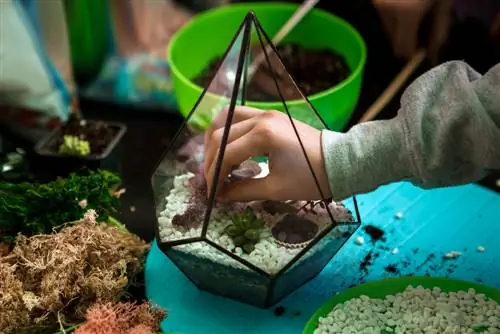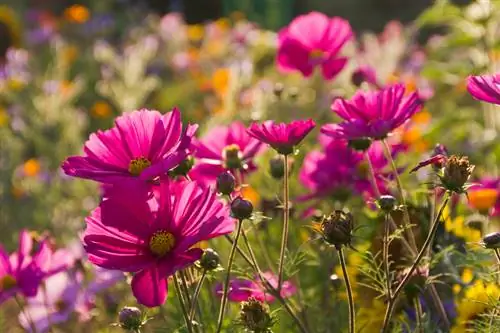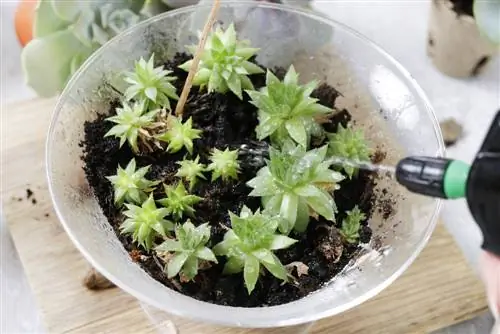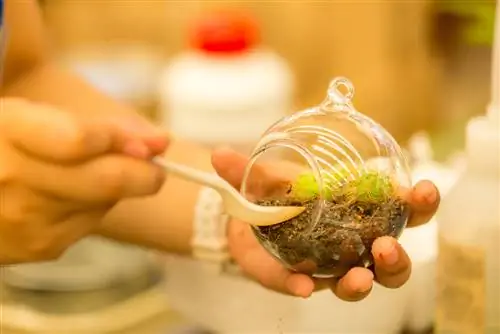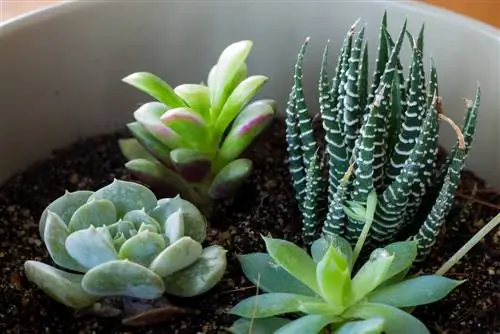- Author admin [email protected].
- Public 2023-12-16 16:46.
- Last modified 2025-06-01 06:02.
Succulents are perfect for imaginative plant compositions in beds, containers and flower pots. To ensure that the bizarre beauties present themselves perfectly, they should be properly placed in the ground. All important questions about the skillful planting of succulents will receive a precise answer here.
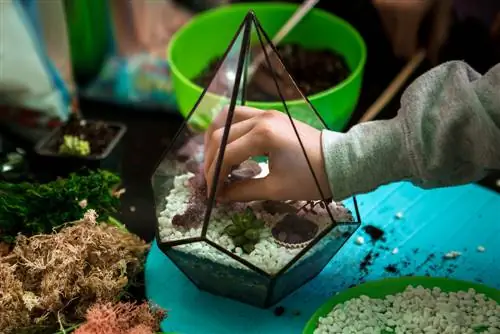
How do I plant succulents correctly?
Succulents prefer a sunny to shady location with at least 4 hours of sunshine daily. You need well-drained, slightly acidic and lean soil. Plant succulents in pots with drainage and use succulent soil or a mixture of humus and inorganic components such as pumice gravel, expanded clay or lava granules.
What location do succulents want?
The large plant family of succulents comes from the sun-drenched, warm regions of the world. Therefore, they all prefer a sunny to shady location with at least 4 hours of sunshine daily, at least in summer time. The majority of succulents are sensitive to cold, so they prefer to be cultivated at normal room temperatures. A few hardy species can withstand temperatures of up to -20 degrees Celsius outdoors if they are equipped with moisture protection.
Leaf cacti are an exception. These come from tropical rainforests where there is eternal twilight. Schlumberga species and varieties, for example, want to be placed in a partially shaded, warm location.
Can I prefer succulents?
Not all succulents are suitable for growing from seeds. Best results can be achieved with cacti and Sempervivum, which often bloom in our regions and therefore produce fruits with seeds. Early spring is the best time to sow seeds in a bright, warm window seat. However, you should have a lot of patience, because it can take up to 12 months before the first seedlings can be transplanted.
Planting succulents in a bowl or pot - how does it work?
Succulents demonstrate their uncomplicated character not only in their care. Planting is easy for even the inexperienced home gardener. How to do it right:
- Spread a layer of expanded clay or pebbles over the bottom opening in the pot or bowl as drainage
- Pour a thin layer of succulent soil on top
- Insert the potted young plants by maintaining the previous planting depth
- Press the substrate and spray with soft water
- Watering for the first time after a regeneration phase of one week
Please note that numerous succulent species are armed with thorns. Therefore, wear spike-resistant gloves if necessary.
What should you pay attention to when planting in the bed?
Please choose a sunny, warm location with well-drained soil. To prevent waterlogging outdoors, fill a 1-2 cm thick layer of grit or pebbles at the bottom of the planting pit as drainage. Enrich the excavation by a third with lime-free quartz sand or lava granules to ensure good permeability. If you have planted the succulents in the garden, the soil should be covered with gravel. This trick prevents the rosettes from coming into direct contact with the ground so that rot cannot form after a rain shower.
What is the composition of the perfect succulent soil?
The ideal succulent soil should primarily be slightly acidic, permeable and lean. Since normal potting soil does not meet these criteria, specialist retailers offer special succulent or cactus soil. Would you like to mix the substrate yourself? Then a mixture of 40 to 60 percent humus and 40 to 60 percent inorganic components, such as pumice gravel, expanded clay, lava granules or lime-free quartz sand, has proven successful.
When is the best time to plant?
For succulents in pots, the planting time is from spring to autumn. The plants should only not be exposed to this stress during the winter rest phase, especially since rooting is delayed for an unnecessarily long time. To plant houseleeks, thickleaf, cactus and colleagues in the bed, please wait until the beginning/mid of May, when there is no longer any risk of ground frost.
Always harden off succulents for outdoors - this is how it works
Succulents are not used to direct sun when they are planted in beds or placed on the balcony. Even desert cacti can suffer irreversible sunburn if they are suddenly exposed to the sun's rays. Therefore, please subject the plants to an acclimatization phase. For this purpose, succulents stay in a partially shaded location in the garden or on the balcony for 8 to 10 days. This precautionary measure applies equally to young and adult specimens.
Propagate succulents - How does it work?
Almost all succulents are easy to propagate. From A, like Aloe, to Z, like Zamioculcas, the following methods have proven to be promising:
- Children or offshoots: cut off, plant in a pot with succulent soil and care for as usual
- Leaf cuttings: cut off, cut conically at the cut point and pot up
- Sowing: Soak seeds, sow, sieve thinly and spray with soft water
If you cut children, offshoots or leaf cuttings, please allow the cuts to dry for 1 to 2 days. On the mother plant, dust the interface with charcoal ash or rock dust. It is important to note that you always use sharp, disinfected tools.
Tip
Small types of succulents, such as houseleeks or cacti, are perfect for the trendy shabby chic. Fill old shoes, mossy clay pots or a worn-out cooking pot with succulent soil to arrange the succulents in. As long as there is an opening in the floor for water drainage or drainage to prevent harmful waterlogging, the exotic pieces of jewelry will feel in good hands there.

